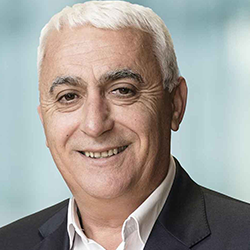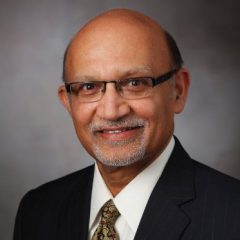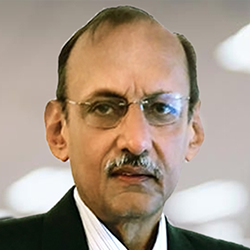IMC 2020
IMC Day 1-Thought Leadership Session
The speakers for this session were Nunzio Mirtillo, Senior Vice President and Head of Market Area South East Asia, Oceania & India, Ericsson; Arun Kumar, Chairman and CEO of KPMG India; Sanjay Mashruwala, Managing Director, Reliance Jio Infocomm; Gopal Vittal, Managing Director & Chief Executive Officer (India & South Asia), Bharti Airtel Limited; Ravinder Takkar, Managing Director and Chief Executive Officer, Vodafone Idea Limited; P Ramakrishna, Chief Executive Officer, India Mobile Congress.
 Nunzio Mirtillo, Senior Vice President and Head of Market Area South East Asia, Oceania & India, Ericsson
Nunzio Mirtillo, Senior Vice President and Head of Market Area South East Asia, Oceania & India, Ericsson
“As the principal sponsor of India Mobile Congress, it is my privilege to welcome you today to IMC 2020 in its new virtual form. The virtual nature of the event has allowed me to join you from home and it really shows the importance of connectivity.
The telecom sector in India and globally has provided the digital infrastructure that has allowed a lot of people in the nation to stay connected during the pandemic, and has allowed us to work from home digitally, without impacting productivity. A year ago, no one would have considered to organize a virtual IMC, but here we are, to gather again, to discuss and deliberate on important topics around inclusive innovation.
The Indian govt’s Digital India platform with its focus on empowerment, inclusion and digital transformation has its foundation on connectivity. And the mobile networks in India continue to deliver on that promise.
At Ericsson, we continue to stay close to our customers and help them provide the best network policy and connectivity to the Indian consumers. Ericsson has been in India for 120 years, since 1903. We have been partnering with our customers in India for the introduction of all mobile technologies, 2G, 3G, 4G and now we are ready for the 5G journey. We have together experienced the massive adoption of 4G technology in India in recent years. 4G remains the dominant technology in 2020, accounting for 63 percent of mobile subscriptions.
India today has the highest average traffic per smartphone user of 16 gigabits per month. The mobile consumption continues to increase, boosted by rapid adoption of 4G and people working from home during COVID-19. For example, the average time spent on mobile broadband has gone up by 2.2 hours per day in India during pandemic, against the world average of 1 hour only. So we have this positive trends of high consumption in India and we cannot underestimate the importance of broadband and connectivity toward the social and economic development of the country. Our global studies show that, on average, a 10 percent increase in the mobile broadband ratio lead to a 0.8 percent increase in GDP. So, connectivity is good. The telecom equipment that is supplied to Indian telecom service providers is made in India. In fact, we were the first to manufacture in India, and we started way back in 1994. We still do so in our Pune facility where we produce 4G and 5G equipment, radios equipment for the Indian market, of course, but we also export from Pune to other countries in Asia.
Ericsson was also the first to show and demonstrate 5G in 2017. During the last 3 years, 5G has risen very fast. We have installed 70 live 5G networks across the world. The consumers in those networks are getting first-hand experience on the technology, better performance, ultra-high speed and very reliable connectivity. We are likely to find more transformative India relevant use cases where speed, latency and security of the 5G network will be there.
Based on our technology leadership and experience in 5G deployment across the globe, at Ericsson, we are in a good position to support India on this 5G journey. We are ready to help our customers switch to 5G, whenever they are ready to do so. Basically, we are ready to go. Networks are as important to the country as roads, electric grids and airports. I strongly encourage India to prioritize actions to incentivize investments in digital infrastructure, including speeding up availability of spectrum and making it more affordable. An encouraging policy framework will provide the enabling environment to help the Indian service providers make a seamless switch from 4G to 5G and help realize the Digital India vision.
Once again, I welcome you all to 3 exciting days of deliberations and discussions at India Mobile Congress.”
 Arun Kumar, Chairman and CEO of KPMG India
Arun Kumar, Chairman and CEO of KPMG India
“KPMG in India is proud to be associated as knowledge partners for this event. This year has reinforced trends with respect to global supply chain realignment, new business models, disruption in industries and alternative way to working, all of which are strongly underscored in the critical role of technology. The government has played a vital role in encouraging the development of the digital economy to landmark programs and initiatives such as the National Broadband Mission, JAM, Digital India, National Digital Communications policy and incentives under the Atmanirbhar Bharat program. These platforms have helped in fostering inclusion and enabling transformation.
Digital services would be critical for future-ready India Inc. Powered by cloud connecting the front, middle and back office will ultimately drive, what we at KMPG call, the connected enterprise.
With this background, it is my pleasure to announce the launch of KPMG in India thought leadership-TMT Industry CEO Outlook-Smart, Secure, Sustainable in association with the IMC and COAI.
Our report shares the insights gathered through a survey of TMT industry CEOs on how the TMT industry is evolving in this extraordinary period of opportunities and challenges.
The research and surveys carried out as part of this report indicate that the outlook of the sector remains positive as 52 percent of the CEOs expressed their confidence in the overall growth prospects of the sector. The survey also indicated that 52 percent of the organizations have accelerated initiatives around digitization of their operations and creation of next generation operating models.
As an increasing number of businesses move towards digitizing their operating models, three prominent trends are emerging:
1) The pandemic has compelled businesses to transition to full or partial remote working environments. Several organizations expedited the implementation of digital initiatives that were staged for next 3 to 5 years;
2) Emerging technologies like IoT, Blockchain and AI are projected to lead strategic investments with robotics and augmented reality-virtual reality emerging at the top. Businesses which delay embracing these technologies may run the risk of falling behind in terms of efficiency, productivity and customer experience.
3) While there could be some delay in the launch of 5G, considering the current COVID-19 situation, with an elongated 4G monetization period in a hypersensitive market, the country can potentially stand to benefit from a delayed adoption through the availability of more mature business use cases, numerous prototypes and a collaborative environment to ensure profitable and sustainable 5G deployment on a large scale.
With digital maturity come digital risks. A significant rise in the usage of digital tools from remote locations and constantly evolving geopolitical dynamics have stoked fears of threats to cybersecurity and data privacy. Over 56 percent of CEOs surveyed, highlighted supply chain disruption as a near-term risk while more than 30 percent of CEOs perceived cyber-risk as both a near-term risk and a long-term risk. Investors, telcos, industry bodies, businesses, expert work groups and government must come together to work on the implementation of challenges to advance India toward a smart, secure and sustainable digital future.
I trust this report will be an exciting, insightful and interesting read for you.”
 Sanjay Mashruwala, Managing Director, Reliance Jio Infocomm
Sanjay Mashruwala, Managing Director, Reliance Jio Infocomm
“Completion of 25 years of milestone for mobile communication is a memorable occasion for many of us who have travelled this route together. Nearly two decades back, while the country was just starting this journey, our founder Chairman, Shri Dhirubhai Ambani had a vision that a phone call could be cheaper than a postcard, which was the most common form of communication then.
And with that vision we began our journey, introducing RIM-Reliance India Mobile, exactly 18 years ago. At Reliance Infocomm, we have a saying, Karlo Duniya Mutthi Mein. What was not said but surely implied was Karlo Duniya Sab Ki Mutthi Mein. A task we are pursuing relentlessly.
And, with the introduction of 4G, we precisely mean Duniya-the broadband data services that bring the world wide web. This has not been a simple journey, of course, but by no means is it over.
2G was like boarding an aircraft, 2.5G pushback, 3G taxiing to runway and 4G take-off. The Udaan has just begun and we have to go high and far. We all understand where we need to go. Our destination is to realise the full potential of Digital India but accelerating the operationalization of cloud native services, IoT, Blockchain, AI, AR/VR and so on, and in delivering education, health, governance and entertainment and more for an all-inclusive India.
During the past few months, the unprecedented pandemic has proved the need for an affordable broadband centric Digital Bharat. The same has been reiterated by our Hon’ble PM time and again. All of us understand the importance to accelerate the indigenous capabilities of 5G and other related technologies so as to deliver on supplier diversity and achieve the stated goal of Atmanirbhar Bharat.
Though India is number 1 in mobile data consumption, we are significantly behind as compared to other nations, be it on fixed line, fiber-to-home, 5G services, the type and size of cloud services and utilization, and so on.
We all know what needs to be done and this includes band and amount of spectrum needed, managing the cost of spectrum, simplifying the permissions, mitigating and removing RoW difficulties and cost as well as allaying any radiation fears. all these have been discussed time and again, with limited progress. It is critical that we recognize data communications as an essential service, rest will fall in place automatically.
In 5G it’s not just about mobility, it is about ubiquitous high speed data through any transmission, technology and media. Of course, 5G is also about related infrastructure, devices and services. Twenty-five years back, we were far behind the developed world in the area of telecommunications. Today, we have made considerable progress, but yet not where we need to be. Let us all collectively work together for India’s leadership in 5G and beyond.”
 Gopal Vittal, Managing Director & Chief Executive Officer (India & South Asia), Bharti Airtel Limited
Gopal Vittal, Managing Director & Chief Executive Officer (India & South Asia), Bharti Airtel Limited
“In 2020, COVID has had a very significant impact on all our lives. In fact, India was the largest nation to put more than 1.3 billion people under a strict lockdown. Besides, the shock to the overall supply chain, many millions were deeply affected from an economic point of view, causing stress on demand and consumption.
Through this crisis, the telecom industry was the backbone for India. Every one of us has been privileged to have played a part in keeping our customers connected in these uncertain times. From children having to take their classes online, to increased digital payments, to businesses finding new ways to keep their employees working, to allowing our customers to have a few moments of entertainment in an otherwise dreary time, we have each played a critical role in their lives.
Now step back and imagine that there was no 4G, no digital networks. How could we have done this? What would have happened to education, to work, to payments, and more? This is truly the power of Digital India. It is the same Digital India that has fundamentally changed our business at Airtel.
Today, more than half of our business is online. 40 percent of our high value customer acquisitions happen online and are delivered straight to the home. Half of your complaints are resolved online. Every one of our one million retailers collect payment from our customers through our Mitra app. Over 50 million customers now use our payments bank to deposit or withdraw cash from their neighbourhood retailer and we have over 165 million users on our digital assets. So, our business today is both, agile and being designed to make the customer omni channel.
But that’s not all, there is something more. That is-the power of purpose. At Airtel, I have heard innumerable inspirational stories, where our teams have gone above and beyond the call of duty, to keep the nation connected during COVID. Our engineers set up networks, fixed faults, climbed towers braving floods and rains. In fact, our Knock, which had 1500 people, was operating with just 15.
Our broadband teams installed 2x the connections, as work from home grew, and each installation takes 3-4 hours. Our sales teams opened up 100,000 new stores, groceries and chemists; our engineering and customer experience care teams declared a war on failure and identified root causes of the problems through daily stand-ups every morning at 9 am, seven days a week. Every one of these amazing people just did their jobs, no one forced them to do it and we did it because it was our purpose.
And it is this purpose that defines everyone at Airtel-to enrich the lives of every Indian by providing them an exceptional experience. And it is the same purpose that is enabling us to meet our customers where they are, and changing our business model dramatically.
Why is purpose important?
For two reasons:
First, the massive opportunity. We believe that there is so much more to do to serve India better, to improve India’s productivity and ensure every Indian benefits. The growth of our industry is uniquely positioned to deliver this through digital technologies and the partnerships we strike.
The second reason is that the Digital India vision can be achieved only through a deep understanding of customers and the problems to solve for them. To do that, we have to be able to adapt the mindsets of our teams, build the right skills and do it an agile way.
In short, we will deliver what India deserves, when we redefine our purpose to serve the needs of every Indian. And in so doing, reimagine our businesses to make that happen.
As a leading telecom player, we will play our part. But I believe there are three things if we have to truly deliver the vision of a Digital India. An India, where every Indian has the right to be connected, to be productive, to be educated regardless of where they live or who they know.
First, we must have an open ecosystem. In the technology world, standards are what make an ecosystem. Many years ago there was a fork in the road, on which technology to back-CDMA or GSM. GSM won, not because it was a better technology. In fact, CDMA was the better technology. But GSM won because it was the more accepted technology. More companies in the world embraced GSM and the rest is history. So, GSM won because it became part of the global ecosystem, and CDMA died! In much the same way, there is sometimes talk of India having its own 5G standards. This is an existential threat which could lock India out of a global ecosystem and slow down the pace of innovation. We would have let our citizens down if we allowed that to happen.
Second, we must create an open India ecosystem and promote applications development, for India and by India.
For this, we have to come together,. We have to set aside our differences and be part of one, the private sector, telcos, equipment players, device players, manufacturing companies, IT companies, every-one can benefit as the growth of technology makes us all more productive. We should collectively sign on to create a 5G ecosystem. And, if there is one thing that IMC can make happen, it is that.
Third, we must have enabling policies, that continue to keep the access to technology affordable. Affordable and easy access to layout fiber which are the nerves of a Digital India. Affordable spectrum that allows to invest in building networks that India deserves.
In conclusion, COVID has in many ways put the entire Digital India vision on steroids. If we can as a country, embrace the global standard, create an open ecosystem for India and leverage this to reimagine our businesses, while having a predictable and simple policy environment, the entrepreneurial energy of Indians will deliver Digital India.”
 Ravinder Takkar, Managing Director and Chief Executive Officer, Vodafone Idea Limited
Ravinder Takkar, Managing Director and Chief Executive Officer, Vodafone Idea Limited
“This year, as we celebrate 25 years of mobile telephony in India and one which turned out to be transformational in many ways, underlining the critical role that telecommunications plays in the lives of people. With a billion mobile users, telecom became the lifeline of India, keeping the nation connected, the economic activities running during the biggest health crisis faced by humanity.
At Vodafone Idea, our network warriors, alongwith enhanced network capacities and contactless services ensured that our customers and businesses remain connected.
Today, India is the second largest telecom market in terms of subscribers and has the largest mobile data consumption globally. This has become possible due to massive private investment in the telecom sector over the last 25 years. The industry has the right structure, with four operators providing adequate competition and innovative services to Indians across the country.
The digital transformation in the country over the last few years is built on the foundation of a ubiquitous broadband wireless network across cities, towns and over half a million villages. And it would not have been possible without the vision of the Honorable Prime Minister and enabling government policies.
On our part, we have invested nearly USD 30 billion in India over the years and remain committed to be partner for Digital India.
We believe in enriching the lives of people with access to real time information, avenues for commerce and enhanced quality of life. We have built the 5G ready network architecture and incorporated technologies to cater to the smart cities, smart machines and smart citizens. From connected cars to connected devices for farmers in agriculture heartland of India, we are using IoT and AI technologies to bring about a positive change in people’s lives across all socio-demographic segments. From automated factories to enabling work from home, online education, healthcare, e-commerce banking, gaming, and digital entertainment to driving financial literacy, woman safety and women empowerment, our GIGAnet is enabling businesses and individuals to stay ahead and thrive.
Looking ahead, we have two distinct opportunities and role for operators:
First, catalyzing India’s specific 5G use cases, creating innovative platforms and partnership models that will positively impact different industry verticals like healthcare, education, smart cities, among others.
Second, getting the bottom pyramid citizens to adopt digital, for ensuring inclusive growth. The rural teledensity is just 59 percent versus 134 percent urban teledensity and nearly 450 million mobile users are not connected to broadband or don’t own a smartphone.
We are prepared to address both these opportunities. Building on our strong network, IT, people capabilities and customer connect, we intend to collaborate with existing ecosystem players and vibrant startups to drive this exciting future.
And there are some challenges too, related to tariffs, taxes, levies, spectrum availability and pricing. The government understands these and have come up with progressive National Digital Communications Policy. And now they are driving the implementation of this policy.
I remain optimistic that with the government support, the industry and our company will script India’s success story over the next 25 years too.”
 P Ramakrishna, Chief Executive Officer, India Mobile Congress
P Ramakrishna, Chief Executive Officer, India Mobile Congress
“It is my pleasure to have you all at this 4th edition of India Mobile Congress 2020 inauguration session. We are truly honored to hold this eclectic mix of dignitaries from across the government and TMT industry and academia to deliberate, discuss the roadmap of smart, secure, sustainable growth of TMT sector in the nation as a whole.
This special edition of IMC is being held virtually for the first time in the light of prevailing conditions. It has been a commendable achievement for us and it would be unfair if I don’t present my vote of thanks to the government, Department of Telecommunications, TRAI, COAI, our 170 sponsors, exhibitor partners, our speakers, our knowledge partner KPMG in India, Dreamcast our virtual partner, George P Johnson our experience marketing partner, our IMC partners, USIBC and IMC board for their support and quickly adapting to the new reality of digital world and embracing the challenge of presenting Asia’s largest technology and communication event virtually.
We sincerely hope that you find the carefully, curated agenda exciting, engaging, and topical relevant and are able make the most of having the entire TMT industry from India and globally on one platform.
Thank you and enjoy the show!”















You must be logged in to post a comment Login